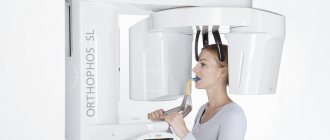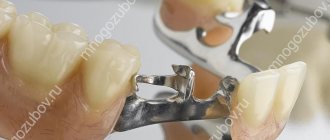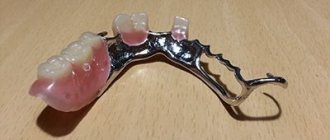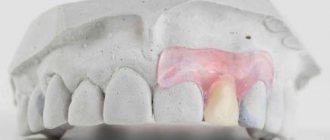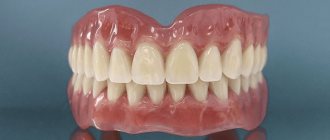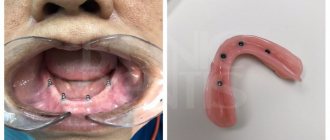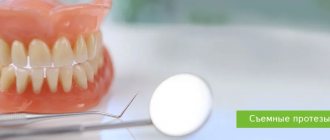Clasp prosthetics is a good alternative to implantation and has a number of advantages over bridge prosthetics. The most popular type is clasp dentures with clasps; this is a more budget-friendly option than those fixed with attachments; it is quickly manufactured and does not require additional grinding of the teeth. They are also used as splinting prostheses.
Clasp dentures on a turnkey basis without additional payments!
Clasp prosthesis on hooks - 40,000 rubles! Clasp prosthesis with locks - 70,000 rubles!
What is a clasp denture with clasps?
“Bugel” (German: bugel)
translated as “arc”. It is the arched metal frame that is the basis of the orthopedic design. A base saddle is welded to it, imitating gums and crowns, artificial teeth. Fixation in the mouth occurs by attaching hooks to the supporting teeth. Hooks are otherwise called clasps. Therefore, clasp dentures with hooks and dentures with clasps are one and the same.
A metal arch and a convenient fastening method have made it possible to reduce the volume of the prosthesis; it is not as massive as a plate one. It takes up less space in the mouth and you quickly get used to it. On the lower jaw it does not interfere with the tongue, it will not move the product from its place, and on the upper jaw it does not block the palate like the same removable acrylic one, which does not cause a gag reflex and does not interfere with talking. Speech is clear and without defects.
Hooks are often made of metal. This provides better fixation, but over time the enamel in the areas of contact may undergo changes. Sometimes technicians combine materials using nylon and acrylic. The first is prone to stretching, which can interfere with the stable retention of the prosthesis, and plastics break easily. In practice, it occurs when the distant supports are made of metal clasps, and in the frontal area they are made of white or transparent material to make the smile area more attractive.
Types of prostheses
There are several types of prostheses, which differ in their design components. Each type of product has its own advantages and disadvantages.
- Clasp prosthesis
The design can have a variety of shapes that correspond to the defect in the dentition. A metal arch connects the base of artificial crowns and fixing elements. The latter are often played by clasps - metal hooks. This clasp is reliable, fully restores function, does not cause complications, and has a long service life. The downside is the lack of aesthetics - in the smile area, the hooks can be noticeable.
- Acrylic prosthesis
The product has a base made of acrylic plastic. The advantages of the design include affordable cost, good strength, simple manufacturing and maintenance processes. The disadvantage of plastic is the rigidity of the material, which you need to get used to, as well as the risk of developing allergies.
- Acree Free prosthesis
A modern clasp made from a new material is called Acree frie. The material does not contain acrylic, therefore it is more biocompatible and hypoallergenic. This base is quite durable, aesthetic and comfortable.
- Nylon dentures
The products are distinguished by the manufacture of a base made of nylon - a soft, elastic, elastic material. Comfortable to use, easy to put on and take off, and look beautiful. Their disadvantage is the need for special cleaning; their service life is only 3-5 years.
Indications for installation
Clasp dentures on hooks are used in the following cases:
- in the absence of several teeth in a row;
- included defects (loss in different places of the jaw);
- end defects (no outer teeth);
- periodontal diseases and tooth mobility from this. The arc prosthesis splints and keeps them stationary;
- increased wear of crowns. The denture covers them, protecting them from further abrasion.
Many patients choose an arched prosthesis because they want to move away from the insufficiently comfortable plate one.
Definition of clasps, their classification
In dentistry, a clasp is a part of a removable denture that ensures reliable fixation of the entire structure in the oral cavity. The simplest option is a hook, but there are also more complex products that perform the function of fastening not only during rest, but also when talking, chewing, sneezing, coughing. The design consists of 3 parts:
- shoulder/shoulders - the part of the clasp that clasps the tooth chosen as a support and presses against the soft tissues, has high elasticity;
- body - connects two other elements, is a smooth continuation of the shoulder;
- process - a part that is almost completely immersed in the base of the prosthesis; sometimes it is attached to the arch of the clasp structure.
The shoulder consists of two parts - supporting and holding, the first makes up 70% of its length. The thickness does not exceed 0.5 mm. The classification of the product in question is complex, because they differ in function, shape, material used, method of covering the abutment tooth and manufacturing methods. The easiest way to navigate the types of retaining structures is by shape - there are only 4 of them: round and flat, semicircular and strip.
Types by method of connection to the base
The connection is provided in three ways:
- rigid/stable - fixedly connected to the prosthesis, there is practically no load on the gum;
- semi-labile (springy) - the body of the hook is long and has a springy property, only a minimal part of the load is applied to the coronal part;
- labile (articular) - the product has a hinge (joint) in its design, which transfers the entire load to the gum and alveolar process.
The choice of the type of connection of the fastening system to the prosthesis is made by the dentist individually, because it is necessary to take into account not only the wishes of the patient, but also the condition of his gums and alveolar process.
Types according to the degree of coverage of abutment teeth
There are three main types of this classification:
- one-armed/two-armed;
- reversible (ring-shaped);
- double.
A multi-link type of fastener is considered separately - this is a front lining on the lingual surface, which is installed in the area where the front teeth are located. It is most often used for lower row prosthetics, when it is necessary to stabilize several teeth at once.
The products in question can be made from different materials:
- titanium alloys, medical steel, nickel and cobalt alloys or any other base metals;
- palladium, gold, platinum - precious metals;
- acetal, nylon, acrylic - synthetic polymers.
All materials have sufficient strength, but have different service life - clasps made of synthetic polymers are considered the most vulnerable.
Contraindications
To install an orthopedic structure, support teeth are required, to which hooks are attached. That is, if you are completely edentulous, the clasp cannot be used. You can use the implantation service. Artificial teeth will securely hold the clasp denture with clasps, while restoring natural metabolic processes in the bone, preventing tissue atrophy.
The supporting teeth must be healthy and strong. They take on the burden of holding and chewing.
If you are allergic to metal, an orthopedic dentist may suggest a metal-free clasp prosthesis. If you are sensitive to other materials of the product, you should consult an allergist and choose with your doctor the best option for prosthetics or implantation.
Manufacturing stages and installation
Prosthetics with clasp dentures with clasps includes two main stages - clinical and laboratory. From the moment you contact the clinic until the restoration of the dentition, the following stages occur:
- Examination. The doctor draws up a prosthetic plan, makes a conclusion about the state of oral health and, if necessary, sends the patient for treatment of caries and/or periodontal disease.
- Taking an impression of both jaws.
- Making a prosthesis in the laboratory. Structures with metal elements are made by casting methods, while plastic ones are produced under exposure to high temperatures.
- Trying on the finished design. If necessary, correction is carried out.
- Installation of the prosthesis.
On average, the clinical and laboratory stages of prosthetics take one week.
Caring for your prosthesis
In order for clasp dentures with hooks to maintain their original appearance for a long time, it is necessary to provide them with fairly simple care, which consists of simple steps:
- brush them twice a day with a brush and toothpaste without harsh abrasives;
- rinse your mouth after eating;
- have your dentures professionally cleaned once a year;
- come every six months for relocation to correct the correct chewing load and its uniform distribution;
- follow all doctor's recommendations;
- apply disinfectant antiseptic tablets, solution, where to place the prosthesis.
If part of the prosthesis or hooks breaks, immediately contact the dentist where the treatment and installation took place.
Indications and contraindications for clasp clasp dentures
These designs are mainly used when the patient is missing one or more teeth, but for some reason does not want or cannot get implants. For example, they are not installed for bruxism, and are sometimes used with restrictions for diabetes mellitus. For the clasp, this does not become an obstacle. Another indication is periodontitis/periodontal disease.
The clasp clasp prosthesis has relatively few contraindications:
- absence of supporting teeth or a situation where there are few of them and/or excess load will be created on them;
- untreated inflammatory diseases in the oral cavity, especially in the area of supporting and restored teeth;
- if the shape of the teeth, gums and/or bite characteristics do not allow the installation of such a structure.
Expert opinion
Roman Borisovich Alekperov
orthopedic dentist
Experience: 24 years
Advantages of clasps over attachments. When there is a need to restore the dentition, and the dental defects are scattered, the patient does not have enough financial resources, I recommend installing clasp dentures with clasps. You quickly get used to them, their production does not require much time, the chewing load is distributed on the teeth, and not on the gums, as is the case with lamellar ones. Yes, the aesthetics are insufficient because of the visible hooks, but you have teeth, you can eat, drink, and live a normal life.
Stages of prosthetics
During the first visit, the dentist assesses the general condition of the patient’s oral cavity and prepares the teeth for prosthetics. The supporting units are ground to fit the crowns (later clasps will be attached to them).
The aesthetic properties of clasp prostheses leave much to be desired: when smiling, during a conversation, metal hooks become noticeable to others
After this, the specialist takes a picture of the patient’s jaw and determines the shade of the future artificial teeth using a scale. Temporary crowns are placed on the prepared units. Next, clasp structures and crowns are made in the laboratory, and when ready, the latter are fixed to the teeth. The dentist tries on the frame of the prosthesis, this is followed by finalizing the product in the laboratory and handing over the removable structure to the patient.
Price
The average cost of a clasp denture with clasps is 35,000 rubles, when choosing a metal-free base (acrifri) - from 60,000 rubles. This includes the material, the work of the dental technician, fitting, and correction. The number of missing teeth in this type of prosthetics does not greatly increase the price. Whereas when fixing with locks, it is interconnected with the number of supporting teeth, and directly with the production of crowns on them.
Other jobs
Advantages and disadvantages
Advantages:
- strength (structures with a metal arc are much stronger than plate ones);
- durability (they last up to 10 years, and plate ones need to be changed every 2-3 years);
- no need to grind the supporting teeth (unlike a bridge, which is fixed only to the processed teeth);
- ease of wearing (due to the thin and non-volume base);
- relatively low cost (cheaper than implants and ceramic bridges);
- assistance in the treatment of periodontal disease (splinting structures hold teeth with pathological mobility).
Minuses:
- low aesthetics (clasps are visible when you smile);
- long addiction (due to the base on the sky, addiction takes a couple of weeks);
- the pressure of the clasps on the tooth enamel (with strong chewing loads, the enamel can be damaged).
To avoid these disadvantages, many choose clasp dentures with locks.
